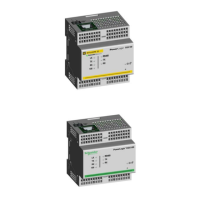63230-319-204A2 PowerLogic™ Ethernet Gateway
12/2008 Setup
© 2008 Schneider Electric. All Rights Reserved.
7
ENGLISH
Serial Port
Action Result
1. From the Setup page, click Serial Port. Opens the Serial Port page.
2. Select your mode, physical interface,
transmission mode, baud rate, parity, and
response timeout (see Table 4 on page 7).
Selects the serial port options.
3. If you select Slave mode, enter the IP
addresses for the remotely connected
devices (see Table 4 on page 7).
Enters the IP addresses of the remote devices.
4. Click Apply. Updates the EGX Serial Port settings.
Figure 3: Serial Port Page
Table 4: Serial Port Settings
Option Description Setting
Mode Used to select how the COM port on the
EGX is utilized (master or slave).
NOTE: When the Mode is changed, the
EGX reboots.
Master, Slave
Default: Master
Physical Interface Used to select how the EGX serial port is
physically wired.
RS485 4-wire, RS485 2-wire,
or RS232
Default: RS485 2-wire
Transmission
Mode
Used to select how data is transmitted over
a serial connection.
Master mode: Automatic,
Modbus ASCII
Slave mode: Modbus RTU,
Modbus ASCII
Default:
• Master mode: Automatic
• Slave mode: Modbus RTU
NOTE: Automatic mode allows
you to communicate to
Modbus RTU, Jbus, and
PowerLogic™ (SY/MAX) slave
devices on the same daisy
chain.
Baud Rate Used to select the data transmission speed
over a serial connection.
2400, 4800, 9600, 19200,
38400, 56000*, 57600*
Default: 19200
Parity Used to select if data is checked for
accuracy using a parity bit.
Even, Odd, None
Default: Even
Response Timeout Used to select how long the EGX will wait
to receive a response from a serial device.
0.1 to 10 seconds
Default: 3 seconds
Remote Modbus
TCP/IP
Connections
(Slave mode only)
Used to define a list of Modbus TCP/IP
addresses for the EGX to use during slave
mode communications.
—
* Available only if the physical interface and transmission mode is RS232/Modbus ASCII.

